
The Agaricomycetes are a class of fungi in the division Basidiomycota. The taxon is roughly identical to that defined for the Homobasidiomycetes by Hibbett & Thorn, with the inclusion of Auriculariales and Sebacinales. It includes not only mushroom-forming fungi, but also most species placed in the deprecated taxa Gasteromycetes and Homobasidiomycetes. Within the subdivision Agaricomycotina, which already excludes the smut and rust fungi, the Agaricomycetes can be further defined by the exclusion of the classes Tremellomycetes and Dacrymycetes, which are generally considered to be jelly fungi. However, a few former "jelly fungi", such as Auricularia, are classified in the Agaricomycetes. According to a 2008 estimate, Agaricomycetes include 17 orders, 100 families, 1147 genera, and about 21000 species. Modern molecular phylogenetic analyses have been since used to help define several new orders in the Agaricomycetes: Amylocorticiales, Jaapiales, Stereopsidales, and Lepidostromatales.
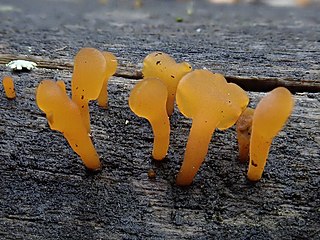
Dacryopinax spathularia is a species of fungus in the family Dacrymycetaceae. Basidiocarps are gelatinous, frequently spathulate (spoon-shaped), and grow on wood, mainly in the tropics and subtropics. The fungus is edible and is commercially cultivated for use as an additive in the food industry.

The Dacrymycetaceae are a family of fungi in the order Dacrymycetales. Species are saprotrophs and occur on dead wood. Their distribution is worldwide. Basidiocarps are ceraceous to gelatinous, often yellow to orange, and variously clavarioid, disc-shaped, cushion-shaped, spathulate, or corticioid (effused).
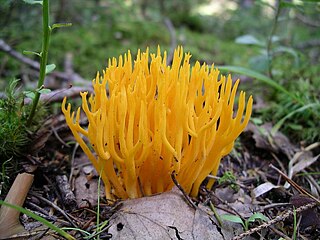
The Dacrymycetes are a class of fungi in the Basidiomycota. The class currently contains the single order Dacrymycetales, with a second proposed order Unilacrymales now treated at the family level. The order contains four families and has a cosmopolitan distribution.
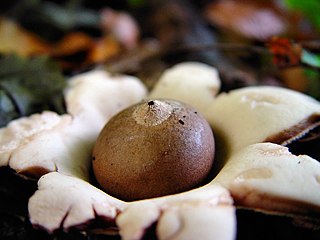
Geastrum is a genus of puffball-like mushrooms in the family Geastraceae. Many species are known commonly as earthstars.

Geoglossaceae is a family of fungi in the order Geoglossales, class Geoglossomycetes. These fungi are broadly known as earth tongues. The ascocarps of most species in the family Geoglossaceae are terrestrial and are generally small, dark in color, and club-shaped with a height of 2–8 cm. The ascospores are typically light-brown to dark-brown and are often multiseptate. Other species of fungi have been known to parasitize ascocarps. The use of a compound microscope is needed for accurate identification.

Mythicomyces is a fungal genus in the family Mythicomycetaceae. A monotypic genus, it contains the single species Mythicomyces corneipes, first described by Elias Fries in 1861. The fungus produces fruit bodies with shiny yellowish-orange to tawny caps that are 1–3 cm (0.4–1.2 in) in diameter. These are supported by stems measuring 2–5.7 cm (0.8–2.2 in) long and 1–2 mm thick. A rare to uncommon species, it is found in northern temperate regions of North America and Europe, where it typically fruits in groups, in wet areas of coniferous forests. There are several species with which M. corneipes might be confused due to a comparable appearance or similar range and habitat, but microscopic characteristics can be used to reliably distinguish between them.
Sarea is a genus of small, non-lichenized, inoperculate discomycete fungi in the family Zythiaceae. Sarea species are found growing on the resin of conifers in the Cupressaceae and Pinaceae in the northern hemisphere. The genus contains two easily distinguishable species: apothecia of Sarea difformis are black, while those of Sarea resinae are orange in color.
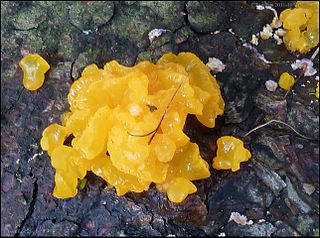
Dacrymyces chrysospermus is a species of jelly fungus in the family Dacrymycetaceae. In the UK it has the recommended English name of orange jelly spot; in North America it is known as orange jelly or orange witch's butter. The species is saprotrophic and grows on dead coniferous wood. Basidiocarps are gelatinous, bright orange, and extremely variable in shape, but typically stoutly stipitate with a spoon- or cup-shaped, spore-bearing head. They are frequently erumpent in groups, often coalescing to form complex masses up to 6 cm (2.4 in) across. Dacrymyces chrysospermus was originally described from New England, but is said to have a worldwide distribution. Microscopically it is distinguished from most other species of Dacrymyces by its comparatively large, 7-septate basidiospores.
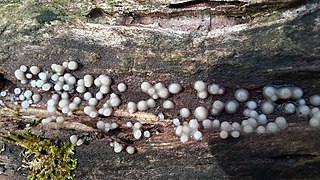
Helicogloea is a genus of fungi in the family Phleogenaceae. Basidiocarps are gelatinous, effused or pustular, and (microscopically) have unclamped hyphae and basidia that are auricularioid. Some species form asexual anamorphs producing conidia. The widespread genus contains more than 20 species.
Cerinomyces is a genus of fungi in the order Dacrymycetales. Species are saprotrophs and occur on dead wood. As originally conceived, the genus comprised species of the Dacrymycetes having effused, corticioid basidiocarps. Molecular research, based on cladistic analysis of DNA sequences, has however shown that this circumscription is not valid. As a result, the genus now contains some species having corticioid basidiocarps and some additional species with gelatinous, pustular basidiocarps. Around 30 species have been described worldwide.
Dacryonaema is a genus of fungi in the order Dacrymycetales. As with other members of the Dacrymycetes, species of Dacryonaema are saprotrophs, occur on dead wood, and have gelatinous basidiocarps. Microscopically all species have clamped hyphae and branched hyphidia.
Geastrum britannicum is a fungal species in the family Geastraceae. Its recommended English name is vaulted earthstar. Like other earthstars, the basidiocarps are initially globose. Their thick outer skin splits open at maturity to expose the puffball-like spore sac surrounded by the split rays of the outer skin. In the vaulted earthstar, the rays split apart and form an arch, raising the spore sac upwards.
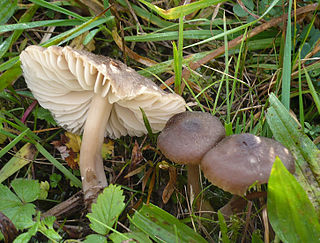
Neohygrocybe nitrata is a species of agaric in the family Hygrophoraceae. It has been given the recommended English name of nitrous waxcap, based on its smell. The species has a European distribution, occurring mainly in agriculturally unimproved grassland. Threats to its habitat have resulted in the species being assessed as globally "vulnerable" on the IUCN Red List of Threatened Species.
Celotheliaceae is a family of fungi in the monotypic order Phaeomoniellales. The family was proposed in 2008 by Robert Lücking, André Aptroot, and Harrie Sipman, while the order was circumscribed in 2015. It is sister to the clade that includes the orders Verrucariales and Chaetothyriales. Molecular clock calculations suggest that the order originated when gymnosperm diversification occurred.
The Dacryonaemataceae are a family of fungi in the order Dacrymycetales. The family currently contains the single genus Dacryonaema with three known species from Europe and North America.
The Unilacrymaceae are a family of fungi in the order Dacrymycetales. The family currently contains the single genus Unilacryma with two known species from Europe, North Asia, and North America. The family was originally placed within its own order, the Unilacrymales, but subsequent research suggests it is better accommodated within the Dacrymycetales.
The Cerinomycetaceae are a family of fungi in the order Dacrymycetales. The family currently contains the single genus Cerinomyces which has a cosmopolitan distribution.
Saccosoma is a genus of fungi in the family Phleogenaceae. Basidiocarps are corticioid, and (microscopically) have unclamped hyphae and basidia that are auricularioid. Some species were formerly referred to as Helicogloea, but molecular research, based on cladistic analysis of DNA sequences, has shown that the two genera are distinct. Saccosoma currently contains 7 species. The genus occurs in both temperate and tropical regions.
Bourdotigloea is a genus of fungi in the family Phleogenaceae. Basidiocarps are effused, waxy, and (microscopically) have unclamped hyphae, conspicuous cystidia, and basidia that are auricularioid. Some species were formerly referred to Helicogloea, but molecular research, based on cladistic analysis of DNA sequences, has shown that the two genera are distinct. Bourdotigloea currently contains 9 species. The genus is known from Europe and North America.










